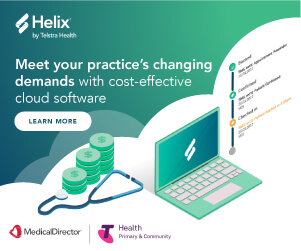Report reveals key trends shaping the future of health in Australia
A recent report by The Melbourne Institute: Applied Economic & Social Research reveals the latest trends likely to shape the medical practitioner workforce and the future of health. MedicalDirector’s Chief Medical Officer, Charlotte Middleton, discusses.
Growth and competition in the medical workforce
According to the Future of the Medical Workforce Report, growth in the medical workforce is expected to expand at 5.3 per cent per year, which is up to 2.7 per cent above the population growth. The flow of junior doctors is increasing at a rate of 8.9 per cent per year since 2005, and the number of GPs is growing by 2.9 per cent per year.
The highest average annual growth in the number of specialist medical practitioners between 2011-12 and 2016-17 were Emergency Medicine (13.6 per cent) and in Oral and Maxillofacial Surgery (13.2 per cent).
Increased job insecurity and competitive pressures may be adding to growing number of doctors reporting burnout, stress, mental health problems, bullying and discrimination, the report found. The report recommends how an improved work culture can significantly increase productivity, team work and patient safety when leading a positive healthcare word environment.
Importantly, the report recommends better distribution of doctors throughout Australia, with clearer pathways to rural practice and Fellowship for GPs, including for international medical graduates (IMGs) working in metropolitan areas. The study also points to supporting more training in rural areas for GPs and specialists.
Recent trends in earnings
Doctors earnings are growing at 1.8 per cent per year above inflation, with increases across most age groups, gender and across most specialities. According to the report, as long as demand for healthcare continues, doctor’s earnings are unlikely to fall.
The overall gap between male and female earnings has been largely unchanged over time, with a slight narrowing in recent years. However, growth in earnings for female doctors aged between 45-54 is higher at 3.5 per cent compared to their male counterparts (2 per cent).
According to the report, this could reflect increased demand for experienced female doctors as male GPs and non-GP specialists may reduce their working hours, while the working hours of females are unchanged or increasing in some age groups.
The highest increase of hourly wages by speciality between 2013 to 2017 is Rheumatology. On the other end of the scale, hourly rates for Endocrinology have plunged minus 2 per cent.
The report reveals fewer restraints in the private sector as public hospitals could apply downward pressure on hourly wages due to the larger number of doctors and fixed hospital budgets. Improved information on fees and out-of-pocket costs will be made available by the Department of Health on a developing website, that is regarded as a key source by the Ministerial Advisory Committee on Out-Of-Pocket Costs (Department of Health, 2018).
Changes to the private medical labour market
Private sectors are most likely to be consumed by doctors than public health hospitals, the report finds. However, this depends on the community’s perception of the value of the private healthcare system.
According to the report, private medical practices might respond to increased competition through consolidation, though this could also reduce consumer choice and raise prices as competition falls. In the future, we could see tighter regulation of the sector if this balance is seen to disadvantage patients.
Benefits of the new digital age
One of the key findings in the report is that technology holds potential and promise for increasing the productivity of healthcare by improving information flows and better use of data, and by bringing doctors and patients together online to improve access to medical care.
The report highlights how the uptake of digital technology by doctors is likely to increase as junior doctors who have grown up using and interacting with it will be expecting to leverage it in their everyday workflow.
Yet despite this growing expectation, the report reveals change could still take time, especially in an industry where there is still widespread use of fax machines rather than email, as well as a range of privacy and medico-legal concerns about the storage and use of data, and treatments provided using new technology. The report finds these issues present a barrier to uptake in the short-term, while in the longer-term, technology could have a range of impacts on the medical workforce.
Key benefits of technology identified in healthcare include:
- Reduced waiting time for certain medical procedures
- Greater innovations in heart surgery
- Saving time and improving health outcomes through automation and artificial intelligence (AI)
- Providing patients with greater access to health information
- Increased efficiency by using electronic health records
- Improving access to healthcare via telehealth (with particular benefits for rural and remote patients, as well as mental health patients).
- Improvements in information flows and better use of data
“Digital decision support systems, such as electronic dashboards and clinical guidelines built into medical software, are an important vehicle for ensuring the uptake of new clinical evidence; providing support and guidance in medical decision-making; and reducing medical practice variations and low-value care,” the report stated. “The ability to share medical records has the potential to reduce duplicate ordering of diagnostic tests, consultation times, investigations and medication errors, as well as improve patient safety and care co-ordination for patients across different healthcare providers.”
What the future looks like
Over the coming years, an increase in the medical workforce supply is set to play a key role in shaping the future of the healthcare system. Increased competition, job insecurity and greater awareness of burnout bullying and harassment, could shift medical training and how junior doctors are supported through the pipeline,
Cultural shifts and gender equality, combined with technological development and greater industry support could pave the way for doctors to have fresh opportunities to offer more collaborative and patient-centric care.









